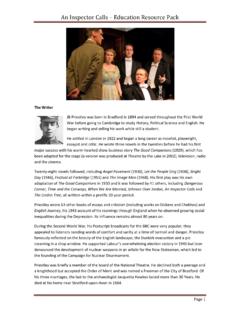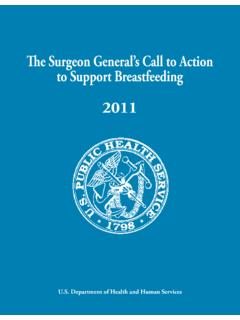Transcription of GCSE English Literature Examiner report Paper 2 …
1 GCSE English Literature Paper 2 Modern texts and poetry report on the Examination 8702 June 2017 Version: Further copies of this report are available from Copyright 2017 AQA and its licensors. All rights reserved. AQA retains the copyright on all its publications. However, registered schools/colleges for AQA are permitted to copy material from this booklet for their own internal use, with the following important exception: AQA cannot give permission to schools/colleges to photocopy any material that is acknowledged to a third party even for internal use within the centre. report ON THE EXAMINATION GCSE English Literature 8702/2 JUNE 2017 3 of 10 Lead Examiner s report 2017: GCSE English Literature 8702/2 This report should be read in conjunction with the report for 8702/1. The design of our new GCSE English Literature assessment focused on enabling students of all abilities to demonstrate their skills within the context of the level of demand created by a closed book, un-tiered Paper .
2 It has been a genuine pleasure to see firm and consistent evidence of students engagement with this qualification and how well they have demonstrated their skills when given a new level of challenge. Students not only coped successfully with the demands of the Paper , but seemed to be liberated in many ways. The aim of this report is to provide feedback on the 2017 exam for teachers. It has been compiled from the views of the entire examination team and will: Provide a general overview of the examination with some key headline messages Exemplify some strengths and key points for each specific section of the exam Provide clarification of the assessment objectives (AOs) and how they are assessed Suggest some advice for students moving forward. General Overview The overwhelming impression was that students coped very well with the demands of the Paper . The majority of responses indicated few issues with access. Time management was largely unproblematic; relatively small numbers of students failed to complete all sections of the Paper .
3 Responses across the ability range were seen, some of which were of exceptionally high quality, maybe suggesting that, for some students, the closed book element was actually an advantage. One senior Examiner commented that she was very impressed with the engagement of the students and their working knowledge of the texts. The design of the mark scheme allowed for a fair and just awarding of marks that exemplified the students intellectual abilities and engagement with the subject. The overall ethos of the qualification is to enable students to demonstrate their engagement with the text they have read in terms of its ideas, the varying contextual factors that influence its creation and reception, and how the writer has consciously constructed the text in order to communicate meaning(s). Therefore, knowing the text was always and by far the best preparation for answering the question.
4 Students who knew the text were able to move around and within it in order to respond to the specifics of the task. One member of the team commented that his future teaching strategy will be to free up all my lessons and really focus on the big ideas in texts after the experience of examining this year . The closed book nature of the exam did not hinder students responses. One member of the senior team noted that, If anything, it may be a positive move: students choose shorter, more pithy quotations; students don t use as many [sometimes unnecessary] quotations; the comment / quote approach may well be avoided; students focus more on their response /their ideas, and references supplement, rather than drive, those ideas . Another member of the team reported that students who knew their text well had no problems with incorporating relevant references and quite often these fell into the category of apt, integrated . Allusions to events, descriptions of actions and paraphrases of dialogue/statements were the main references apart from actual quotations.
5 report ON THE EXAMINATION GCSE English Literature 8702/2 JUNE 2017 4 of 10 Students who answered the question generally did better than those who were confined by formulaic, AO-driven responses. Those who had been taught to deal with the text through the lens of the actual question generally produced more effective responses. The use of structures such as PEE / PEA and its variants worked in the sense that they allowed students working at the lower levels to access Level 3 in the mark scheme. However less rigid structures worked better for those working at higher levels. The flexibility of AO1 in allowing students to reference the text in a variety of ways liberated them to use the text as illustration of their response in whichever way they saw fit. The overwhelming majority of students had internalised the requirements of the task and focused clearly on the key elements of the question they had selected. Where students miss an essential element of the task, such as the focus on a particular character, this is managed via a rubric infringement mechanism which protects the candidature as a whole by ensuring equity of assessment in terms of the requirements of each particular question.
6 For example, some students misread the focus on Mrs Birling for Q1 and instead wrote about Mr Birling. All such responses were marked positively, rewarding students for the quality of their response, but it is appropriate to acknowledge when a candidate has not responded to the task. Therefore, in the case of this particular question in this particular series, we operated an AO1 task adjustment only. The adjustment in this particular case reflected the fact that there are two characters with the same surname referred to in An Inspector Calls. Students made huge efforts to use subject terminology and many did so with accuracy. However, at times students were more concerned with the use of technical terms than the effect. Students should remember that critical terms should be used judiciously and must always be linked to effect on the reader/audience. Students who answered the question did better on AO3 than those who tried to include biographical and / or historical information, which is difficult to credit.
7 Section A: The Modern Text It is perhaps not surprising that An Inspector Calls was the most prevalent choice for Section A with over 60% of students answering on this text. The second group of popular texts included Lord of the Flies, Blood Brothers, Animal Farm and DNA. There was no particular ability pattern to these text choices and responses across the ability range were seen, perhaps suggesting that their respective selection could have been driven by teacher preference and knowledge of their students. Of the new texts, Pigeon English generated some particularly vibrant and engaged responses from students. Where Telling Tales was used, there were some excellent responses, although it is worth mentioning here that there is no requirement to compare the two stories being covered. Responses across all levels were fresh and genuine in the most part. Where students knew the texts well, the questions were answered fully with details carefully selected.
8 There was very little evidence of prepared answers but a lot of evidence of well-prepared students who knew the texts and had ideas about them. Those who knew their text were able to refer to different points in it and demonstrate their understanding that way. There were a number of very impressive responses where the student had taken a more holistic view of the text as a whole. The overwhelming view from the examining team was that connection with the whole text by the student is vital in allowing them to explore the ideas raised by the steer of a task. Students who rooted their response in their selected task put themselves in a stronger position. The key words in each question point students toward the three AOs being assessed, so those who took this approach naturally gave themselves a firmer foundation from which to develop an appropriate response. Where students didn t focus on the task itself, they tended to self-penalise.
9 report ON THE EXAMINATION GCSE English Literature 8702/2 JUNE 2017 5 of 10 For example, some responses to Q2 on An Inspector Calls forgot to write about how Priestley was using the Inspector to explore how society could be improved and gave a more narrative answer simply looking at how the Inspector forced the family to confront their wrong doings, or recounting the action of the play. Students who dealt with AO2 most successfully were the ones who had not been too restricted by subject terminology. Some students became tied up in the confusion and found themselves wrongly identifying parts of speech without actually saying anything about meaning, let alone effects. There were however some very successful treatments of AO2 that concentrated on why and how a writer has crafted a character / moment / exchange of dialogue / point of tension. For example, in response to Q2 about society, one student wrote about the significance of dramatic irony in An Inspector Calls.
10 They focused on unpicking Mr. Birling s speech about the Titanic, absolutely unsinkable . A short quotation such as this, alongside the acknowledgment that this is dramatic irony, followed by a consideration of why Priestley chooses to present Birling in this way, is a good example of how AO2 can be addressed. Sometimes, too much terminology impeded responses and seemed to constrict liberation of ideas and expression. Some students moved into Level 6 for AO2 via a thread that ran throughout their response explaining how the writer was working to present ideas rather than focusing solely on analysis of techniques, words or phrases. In An Inspector Calls, much good use was made of stage directions, lighting and structure to comment on AO2. Students who had used character development / purpose as their focus for AO2 produced some very effective responses as they were explicitly focusing on writer as maker of the text.















